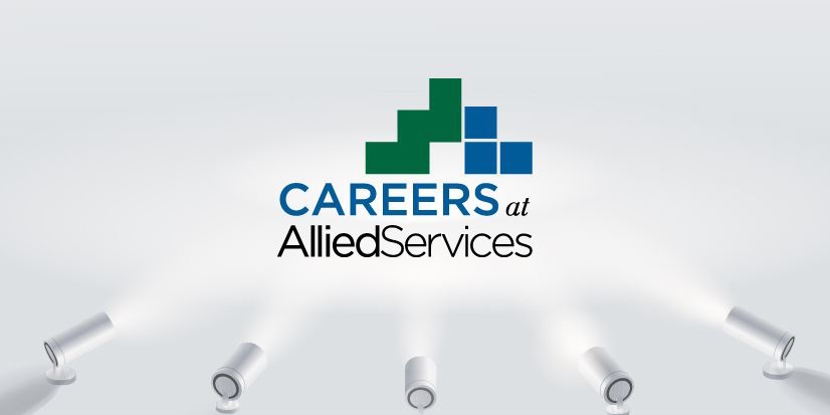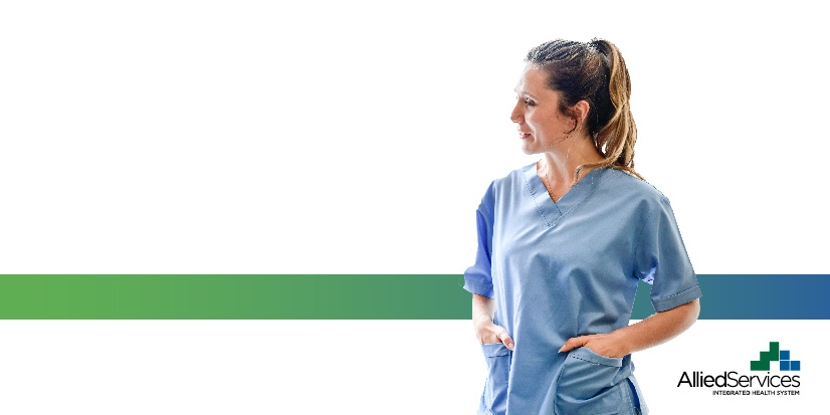Stroke Recovery, a Lifelong Journey
- Category: News, Stroke Recovery
- Posted On:
- Written By: Allied Services Integrated Health

When a loved one has a stroke, the days, weeks, and months following can be filled with uncertainty, change, and questions. Lots of questions. Will I walk again? Will I be able to work again? Will life ever return to normal for me? As an occupational therapist in an Inpatient Rehabilitation Facility, I am among the first rehabilitation specialists to work with stroke survivors and their families.
A common question I get asked is, how long will recovery take? The question has no simple answer. This is because each stroke and each patient is unique. We do know, however, that certain factors have an impact on patient outcomes.
When someone has a stroke, the brain’s supply of blood, oxygen, and nutrients is interrupted or reduced. As a result, brain cells begin to die in minutes. A stroke can cause temporary or permanent disability, including complications such as paralysis or loss of muscle movement, memory loss or cognitive difficulties, speech and swallowing difficulties, and emotional problems.
The size and the location of the stroke are both significant for recovery. For example, if a stroke is mild, the damage may be minor, leading to a swifter recovery. A stroke can affect many different brain areas, with differing outcomes. For example, if a stroke occurs on the right side of the brain, vision problems are possible. Even when two patients experience similar strokes in size and location, the recovery timelines vary greatly. This can come from age, the patient’s overall pre-stroke health, and comorbidities.
Further factors, such as the type and intensity of post-stroke rehabilitation, can further impact an individual’s rate and range of progress.
Stroke rehabilitation aims to restore lost functions and promote functional gains necessary for independence. Stroke rehabilitation can occur across a continuum of care, including Inpatient Rehabilitation, Transitional Rehabilitation, Skilled Nursing, Home Health, or Outpatient Rehabilitation.
The American Stroke Association strongly recommends that stroke rehabilitation begins with a stay in an Inpatient Rehabilitation Facility. In this particular setting, a multidisciplinary team of rehabilitation medical professionals delivers personalized treatment plans based on the needs and goals of the patient. From here, patients may return home or to another level of care, depending on their progress.
A 2015 study published in the American Heart Association’s journal, Stroke, reported that patients' functional and motor performance at five years post-stroke was equivalent to the level measured at two months. While this might initially seem disheartening, there is more to this finding to provide hope for stroke patients.
The brain’s ability to rebuild or rewire – a quality called neuroplasticity – can hold the key to progress in stroke recovery. During the initial stages of recovery, the brain can temporarily increase neural general and reorganization, making intensive rehabilitation more effective than later. Researchers credited the initial gains during the first two months of recovery with the intensity of inpatient rehabilitation.
This period of extra or heightened plasticity ends, usually around the three to the six-month post-stroke mark. This is when plateaus can occur. However, advances in rehabilitation protocols and technology mean that plateaus can be overcome, and patients can continue to see progress years after stroke.
While the 2015 study measured patient outcomes and functional abilities at two months and five years, it did not include data from any other intervals. Between the two-month and five-year marks are many variables such as motivation, family support, participation in, and frequency of rehabilitation.
It can be easy for stroke patients, families, and caregivers to think of recovery as a single straight line. Perhaps, the phrase “stroke recovery journey” describes the unpredictable, lifelong process of rehabilitating from a stroke. The variables of stroke recovery should offer patients and loved ones hope. You can take steps in the days, weeks, months, and years post-stroke to see progress. Find an experienced stroke rehabilitation specialist, enlist the support of your family, and never stop working on your recovery. To learn more about stroke rehabilitation decisions and resources, visit stroke.org/recovery
Carol Weisenfluh, OTR/L, is Stroke Program Manager at Allied Services Scranton Rehab Hospital.
Inpatient Stroke Recovery at Allied Services
At Allied Services Integrated Health System, we provide comprehensive rehabilitation services in Scranton and Wilkes-Barre. Inpatient stroke rehabilitation is the first step in their recovery for many stroke patients.
To learn more about how we can help with stroke recovery, please call us at 570-348-1359 in Scranton and at 570-826-3885in Wilkes-Barre.
Outpatient Rehab Services for Stroke
At Allied Services, our Stroke Recovery Program includes comprehensive outpatient rehabilitation services that help increase patients' independence and quality of life after a stroke. Our rehabilitation medical professionals are highly trained in treating stroke, whether in the days, weeks, or years following a stroke.
To learn more about how we can help with stroke recovery, please call us at 570-348-1360 in Scranton and at 570-826-3900 in Wilkes-Barre.



